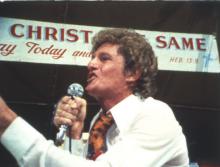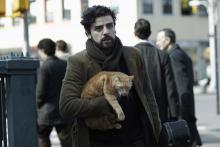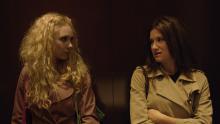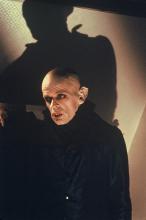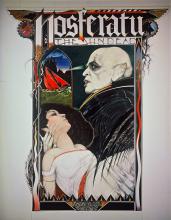These notes on Howard Smith and Sarah Kernochan's 1972 documentary Marjoe, were written by Leo Rubinkowski Ph.D candidate, Film Studies, Communication Arts Department. Marjoe screens Friday, March 7 at 7 p.m. in the Cinematheque's regular venue, 4070 Vilas Hall
“No matter how you slice it, it still comes out as self-exploitation of a sort that strikes me as being exceedingly sleazy.”
Vincent Canby chose these words to describe Marjoe in a New York Times review of the 1972 documentary, but his acid criticism arguably applies just as well to Marjoe Gortner’s first brush with national exposure. At four years of age, the “World’s Youngest Minister” married Raymond Miller and Alma Brown in a ceremony apparently calculated to prove the adage “There’s no such thing as bad publicity.” Indeed, while clergy, legislators, and onlookers criticized the Long Beach wedding and its pint-sized presider (Life Magazine quoted one Catholic priest: “The child is as incapable of witnessing a contract as Charlie McCarthy.” ), the Gortner’s reaped just the rewards they had sought. The boy’s fame spread within Pentecostal communities, he toured the revival and church circuit as a star attraction, and his income supported the family for several years, until deceit, divorce, and disillusionment ended that part of Marjoe’s life.
The sensational details of our protagonist’s early years exist primarily as background, though. In a sense, it is the cherubic tyke greeting viewers with his excited “Howdy, neighbors! May the Lord bless you!” who justifies the documentary, but Marjoe’s ambitions exceed the biographical in at least two respects.
First, the filmmakers have clearly designed the film to comment on the Pentecostal community through which Gortner escorted them during production. Juxtapositions between images, as well as between sound and image, allow Kernochan and Smith to substantiate Marjoe’s cynicism in interviews. During the first extended sequence in which we see Gortner work a crowd, there is an abrupt and brief change of scene from the tent to an office, wherein we find Marjoe and his host dividing the night’s take. Later, during the 24-Hour Prayer Crusade sequence, a close-up of the lead preacher’s gaudy, glittering broach complements audio of her assurances that donations will not be wasted on foolishness. At every turn, Marjoe works to remind its audience that big religion means big business for traveling evangelists. Most often, it is Marjoe himself who makes the case, his status as a leading participant grounding his authority as a chief skeptic. Who but a professional could have provided the film crew with careful instructions for filming congregants speaking in tongues?
Significantly, however, Gortner’s expertise also complicates whatever commentary viewers find lurking within the film’s mise-en-scène, cinematography, sound, and editing. For one thing, Gortner’s explicit criticisms of the business of religion are just that: criticisms of the business of religion. If he is frustrated with the close-mindedness of his flocks, his comments are more damning of their shepherds. At the same time, and still counting himself among the wolves in sheep’s clothing, Gortner is also on record rationalizing the business. In a conversation with Grace Lichtenstein for a Sunday issue of the New York Times in August 1972, he explained: “I justified it, in a sense. These people don’t go to any musical comedy. They spend no money on alcohol. It’s a sin to go to the movies. [Was this a source of comfort for Gortner?] Their only form of entertainment is these revivals. You figure you spend $3.50, $4 on a movie, well, that’s about what I got [per person in offerings]. And I gave them a show.” By this logic, entertainers who entertain deserve compensation for their labor, even if they are frauds. Though Gortner apparently never wholly embraced this position, it remains a provocative one, especially in light of Marjoe’s second aim.
In the same review cited above, Vincent Canby observes that the film is “less a documentary about Marjoe’s final weeks on the Pentecostal church-and-tent circuit than a feature-length screen test.” Indeed, at the time of Marjoe’s production, its namesake was looking for an opportunity to leave preaching for work as a musician or an actor, and this film was only the latest attempt at making the transition. He certainly had chops. Many reviewers echoed Lichtenstein’s claim that Gortner was “evangelism’s answer to Mick Jagger.” The justification is obvious. Microphone to his lips, left hand on his hip, arm cocked back, and marching his svelte frame before the pulpit, Marjoe reproduces the lead singer’s mannerisms almost to a tee. (There’s a joke about Marjoe’s sympathy for the devil’s music hiding here…) To extend the comparison, Marjoe itself treats its subject as though he were a famous musician on tour, perhaps inspired by the example of vérité films like those of D.A. Pennebaker. Much of the 88-minute running time is organized around three tent meetings and a 24-Hour Prayer Crusade. In each case, footage and audio organize our attention around Marjoe, so that he is always either audible or visible. Viewers are also regularly treated to the sounds and images of Gortner’s audiences as they react to his presence and message with devotion and fervor. In between these gigs, Marjoe takes its audiences “behind the scenes.” In the last of these sequences, when Marjoe converts a dog, the two threads running throughout the film intertwine – Gortner may not believe in what he is doing, but his talent is so thoroughly honed that his audiences cannot tell the difference between performance and witness, if there is a practical difference at all.
Marjoe may have been exploitative, but it was also successful. The film won the Academy Award for Best Documentary Feature of 1972, and Gortner quickly found his way to Hollywood. After peaking with his appearance in the disaster classic Earthquake (1974), Marjoe continued to work through the next two decades, taking primarily minor television roles or leading and supporting roles in minor films, such as the Star Wars knock-off Starcrash (1978) and the Evel Knievel vehicle Viva Knievel! (1977).
Lasting fame may never have been in the cards for Marjoe Gortner, but thanks to Marjoe, he remains something more than a footnote in history. “Glory gee to besus!”

